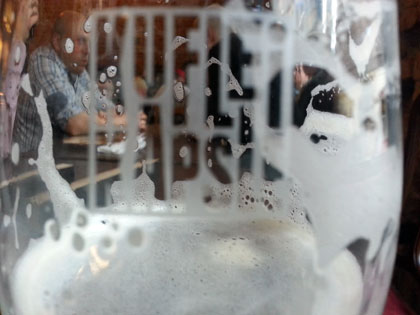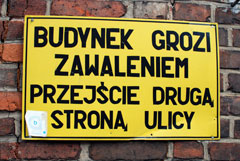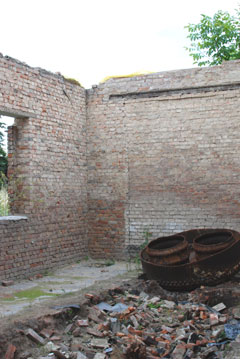Another example of beer from a place.



Kufle i Kapsle
Nowogrodzka 25
00-511 Śródmieście, Warszawa
Another example of beer from a place.



Kufle i Kapsle
Nowogrodzka 25
00-511 Śródmieście, Warszawa
 Bill Kostkas has posted the roundup for The Session #89: Beer in History.
Bill Kostkas has posted the roundup for The Session #89: Beer in History.
His own contribution to The Session left me thinking about our recent travels in Poland.
Battlefield Brew Works just up the York Road outside of Gettysburg proper is one of my favorite brewpubs in the entire Commonwealth. The bar inside is crafted from trees that were grown on the farm’s property when it actually used to be a farm. The establishment itself is completely inside an 1860’s style Pennsylvania Dutch barn.
The Brew Works sits on what once was (or kind of still is) the Monfort Farm just outside of Gettysburg. At one point during and for some time after the Battle of Gettysburg the barn was used as a field hospital and is designated as such by a plate on a fireplace inside. I can honestly say that in my two plus years of doing things and recording some of them on this blog that this one was the most excited I have ever been to combine both beer and history. I can’t wait to return next month.
We’re kind of hit and miss in the United States about preserving the past (or conserving the present, but that’s another discussion). But at least the continent hasn’t had to host a world war. It is a delight to stroll through Warsaw’s Old Town, which was established in the thirteenth century, and point to this or that cool bit of architecture. Except, of course, the one-time city center had to be rebuilt after World War II. Nazi troops leveled 85 percent of it during the Warsaw Uprising in 1944.
Considering history from time to time can help keep beer in perspective. Feel free to resume drinking.
MONDAY BEER LINKS, MUSING 07.07.14
England’s Franconia. Add Dudley and the Black Country to the list of must visit destinations in England. Next time somebody asks for an example of beer from a place I’m pointing to this URL.
[Via I Might Have a Glass of Beer]
Why Beer History? Tom Cizauskas turned his blog over to historian Maureen O’Prey for The Session (it was Friday; I lose blogging karma points because things were silent here). She sets the bar high, “As a historian, my mandate is to unearth the accounts of these brewers and share them with the world. Every brewer’s story should be documented, however grand, or seemingly inconsequential.”
[Via Yours for Good Fermentables]
The Art of Craft Beer. Who is Art Larrance (other than the buy who started the Oregon Brewers Festival)? A profile.
[Via Oregon Beer Growler]
Cal Poly Pomona to offer new beer brewing class, build microbrewery on campus. I’m passing this along mostly because I didn’t know that California was considering a “sip and spit” law that allows students younger than 21 to taste beer (and wine) when they take particular college course. But it also reminds me of a question that Dr. Michael Lewis (who started the brewing program at UC-Davis before Sierra Nevada Brewing was even open) asked at the Craft Brewers Conference: Who will be accrediting the institutions that are accrediting the brewers?
[Via San Gabriel Valley Tribune]
Anthony Bourdain’s Theory on the Foodie Revolution. What if you replaced the words food, cooking and eating with beer, brewing and drinking in the first paragraph? “It won’t be surprising if cultural historians look back on the first two decades of this century as The Era of Crazed Oral Gratification. I’m speaking of the fetishization of food, of cooking and eating, of watching other people cooking and eating, that has become omnipresent across all platforms, all media, all screens and all palates in our great nation.”
And that’s before Bourdain cuts loose.
[Via Smithsonian magazine]
A sign* on a pillar in what was the malt house for the last brewery to operate in the Polish town of Grodzisk Wielkopolski indicates Grodziskie beer may be purchased here.
Well, not quite yet. However, renovation has begun at the complex, with plans for brewing to resume early in 2015.

Daria and I visited the site last week along with Jan Szala, a member of the commission formed to revive the style, and Marian Bochyński. Bochyński has the largest collection of Grodziskie breweriana of anybody anywhere. Szala was last in the buildings, where brewing ended in in 1993, two years ago. He said they looked much more like a brewery then. Today every one is basically an empty shell.
 Grodzisk, home to about 14,000 people, is totally charming. Bochyński led us past three buildings in other parts of town that were once breweries. Grodzisk had 53 at the end of the eighteenth century and still five, all much bigger and selling their beer in far away posts, at the beginning of the twentieth. The warning sign to the right — Jan explained it basically says to stand away from the building because it is in danger of collapsing — is posted on the side of one of them.
Grodzisk, home to about 14,000 people, is totally charming. Bochyński led us past three buildings in other parts of town that were once breweries. Grodzisk had 53 at the end of the eighteenth century and still five, all much bigger and selling their beer in far away posts, at the beginning of the twentieth. The warning sign to the right — Jan explained it basically says to stand away from the building because it is in danger of collapsing — is posted on the side of one of them.
 I’m not sure standing in the middle of this brewery in waiting if it is easier to envision what it once looked like or what it will look like. Jan shook his head as we walked away, saying he couldn’t believe they’d be brewing only months from now. But it turns out he hasn’t visited Browar Fortuna, about 100 kilometers to the east, recently. There the same four principals involved in Grodzisk have modernized a regional brewery that was slowly grinding to a halt.
I’m not sure standing in the middle of this brewery in waiting if it is easier to envision what it once looked like or what it will look like. Jan shook his head as we walked away, saying he couldn’t believe they’d be brewing only months from now. But it turns out he hasn’t visited Browar Fortuna, about 100 kilometers to the east, recently. There the same four principals involved in Grodzisk have modernized a regional brewery that was slowly grinding to a halt.
When they took over Fortuna, founded 125 years ago, little more than three years ago sales had shrunk to 10,000 hectoliters a year. They don’t generally talk about production figures but it seems they are on track to sell six to eight times that in 2014. Before we went to Miloslaw, I asked homebrewers about Fortuna and they said the beers tasted of iron — the flavor, some say of blood, you get when you put a penny in your mouth. They need to taste the beers again. Almost bit of equipment involved in the brewing process has been cleaned up or replaced.
I have no idea if these guys will succeed selling a style of beer that died a natural death, but it’s pretty clear that what they make will be well brewed.
There’s a fascinating beer story unfolding in Poland. One that’s not just about Grodziskie and one that deserves to be told properly, I think as my contribution to “Beer Trails.” This will take some time, though not as long as rebuilding such a valuable piece of the past.
* Click on it to enlarge the photo at the top.
MONDAY BEER LINKS, MUSING 06.23.14 & 6.30.14
OK, it’s Wednesday, not Monday, but I have some catching up to do.
First, a quick combination from print. In the July issue of Beer Advocate magazine Andy Crouch writes “We are unquestionably in the Age of IPA” and suggests that there is “some hazard in letting a single style define craft beer so completely.” I don’t think that’s going to be a problem, in part because of what he hits on at the end. Flavor is driving escalating sales of beers with flavor. That reads a little simplistic, I know, but the point is we’re talking about new flavors, not just hop aromas and flavors. Meanwhile, Josh Bernstein writes about the evolution of IPA in Imbibe magazine (linked because it is online, but you might want to buy the magazine to get the nice timeline that accompanies the story).
Now, two weeks worth of links and a minimum of musing.
Is Sam Adams Too Big to Be Craft Beer? I missed the press release while we were in Poland, but apparently Tony Magee of Lagunitas is now in charge of determining what constitutes “craft beer.” From the article: “Magee said that Sam Adams has ‘so little to do with what beer is doing today.’ In other words, Sam Adams may have once been craft, but its size and lack of innovation mean it can no longer qualify.” Enos Sarris, who wrote the article, apparently agrees, concluding, “It started a craft beer revolution, and then craft beer’s evolution passed it by.” Musing: Bullshit. [Via FiveThirtyEight]
When Craft Beer Becomes a Commodity and Big Brewers Making Specialty Beer: Lessons from MillerCoors. A combination from Jeff Alworth meant to be read in combination. Musing: Sierra Nevada Brewing will make more than one million barrels (as much as the entire “craft” segment minus contract-brewed Samuel Adams and Pete’s Wicked Ales just 20 years ago) this year. Friday night at The Second City in Chicago I expect to have a hard choice to make between drinking Sierra Nevada Pale Ale and locally brewed Half Acre Daisy Cutter Pale Ale. They are not interchangeable. [Via Beervana]
Is Sierra Nevada Overvalued? The Curious Case of the “Boring” Beer. Musing: See above. [Via This Is Why I’m Drunk]
Style from Adrian Tierney-Jones provokes What Are the Elements of Style? from Alan McLeod. Musing: Strunk and White would be proud. [Via A Good Beer Blog]
Rising Hops Prices Make Craft Brewers Jumpy and The real value of hops. The first one is behind a firewall, so if the link doesn’t work be creative. The second provides perspective. Musing: Things are just starting to get interesting. [Via Wall Street Journal and Brewer’s Guardian]
Your Favorite Local Brewery is Not Selling Out. Musing: I expected more after seeing the headline, but the comments add another layer of persepctive. [Via The Full Pint]
Blind Tasting: Unreliable but Necessary. “That is one of the most useful features of blind tasting: to be disturbed. To ask yourself, do I really like what I like? Or do I like it because I think I should?” Musing: I drink plenty of beer “blind” because I judge beer, and I usually don’t end up knowing what those beers were. I find myself less interested these days in learning what I might in a blind tasting than I will seeing, and learning about, just what I am drinking. [Via Palate Press]